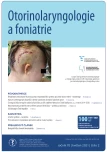First experiences with bone conduction implant Sophono
Authors:
Varga L. 1,2; Bercíková B. 1; Kabátová Z. 1; Profant M. 1
Authors‘ workplace:
Klinika otorinolaryngológie a chirurgie hlavy a krku LF UK a UN Bratislava
1; Laboratórium Diabgene ÚEE, Biomedicínske centrum SAV, Bratislava
2
Published in:
Otorinolaryngol Foniatr, 70, 2021, No. 2, pp. 102-108.
Category:
Case Reports
doi:
https://doi.org/10.48095/ccorl2021102
Overview
Introduction: Bone conduction implants are currently used for rehabilitation of conductive and mixed hearing loss as well as for single sided deafness. A growing number of these implants available on the market increases requirements on detailed knowledge on their technical properties, and on their advantages and disadvantages in clinical practice. Sophono is one of the recent members in this implant group. The aim of the study is to summarize our first experiences with Sophono at our implantation center in Bratislava. Patients and methods: We present data of the first two adult patients who underwent Sophono implantation. Both suffered from bilateral conductive hearing loss of different etiology. We focused on their audiological functional outcomes, basic surgical aspects and subjective assessment by the patients. Results: In free field tone audiometry with the implant, both patients achieved improvement of hearing thresholds by 21.25 dB and 31.25 dB, respectively. In speech tests with and without noise, we also demonstrated a clear benefit of the implant, which was in a narrow relationship with the degrees of their hearing loss: speech discrimination scores in noise were 30% and 60% in patients 1 and 2, respectively. The surgical procedure in Sophono implantation is relatively simple and does not include any work on middle ear structures. Patient satisfaction with the implant does not always correspond to the measured functional outcomes. Conclusion: The Sophono implant represents a suitable option for rehabilitation of conductive and mixed hearing loss as well as single sided deafness in selected patients. The candidate selection is always based on comprehensive assessment in which the audiological results are an elementary criterion, but definitely not a single one.
Keywords:
Sophono – implantation – conductive hearing loss
Sources
1. Skřivan J. Přehled implantátů pro kostní vedení a aktivních středoušních implantátů. Otorinolaryngol Foniatr 2018; 67(3): 68–74.
2. Gál B, Talach T, Veselý M et al. Bonebridge – nový aktivní implantabilní systém pro přímé kostní vedení. Otorinolaryngol Foniatr 2018; 67(2): 50–55.
3. Siegert R. Partially implantable bone conduction hearing aids without a percutaneous abutment (Otomag): technique and preliminary clinical results. Adv Otorhinolaryngol 2011; 71: 41–46. Doi: 10.1159/ 000323720.
4. Hakansson B, Tjellstrom A, Rosenhall U et al. The bone-anchored hearing aid. Principal design and a psychoacoustical evaluation. Acta Otolaryngol 1985; 100(3–4): 229–239. Doi: 10.3109/ 00016488509104785.
5. Hol MK, Nelissen RC, Agterberg MJ et al. Comparison between a new implantable trans - cutaneous bone conductor and percutaneous bone-conduction hearing implant. Otol Neurotol 2013; 34(6): 1071–1075. Doi: 10.1097/ MAO.0b013e3182868608.
6. Kohan D, Ghossaini SN. Osseointegrated auditory devices-transcutaneous: Sophono and Baha attract. Otolaryngol Clin North Am 2019; 52(2): 253–263. Doi: 10.1016/ j.otc.2018.11.013.
7. McLean T, Pai I, Philipatos A et al. The Sophono bone-conduction system: Surgical, audiologic, and quality-of-life outcomes. Ear Nose Throat J 2017; 96(7): E28–E33. Doi: 10.1177/ 014556131709600706.
8. Zernotti ME, Di Gregorio MF, Galeazzi P et al. Comparative outcomes of active and passive hearing devices by transcutaneous bone conduction. Acta Otolaryngol 2016; 136(6): 556–558. Doi: 10.3109/ 00016489.2016.1143119.
9. Bezdjian A, Bruijnzeel H, Daniel SJ et al. Preliminary audiologic and peri-operative outcomes of the Sophono transcutaneous bone conduction device: A systematic review. Int J Pediatr Otorhinolaryngol 2017; 101: 196–203. Doi: 10.1016/ j.ijporl.2017.08.014.
Labels
Audiology Paediatric ENT ENT (Otorhinolaryngology)Article was published in
Otorhinolaryngology and Phoniatrics

2021 Issue 2
Most read in this issue
- Biological therapy of chronic rhinosinusitis
- Grisel’s syndrome – case report
- Surgical treatment of benign parotid gland tumors in the years 2014–2018 at the ENT department of Hospital České Budějovice, a.s.
- Neuromonitoring of the recurrent laryngeal nerve in thyroid gland surgery – results and experiences
